Notes
Jon Lowenstein on the South Side: Shots Fired
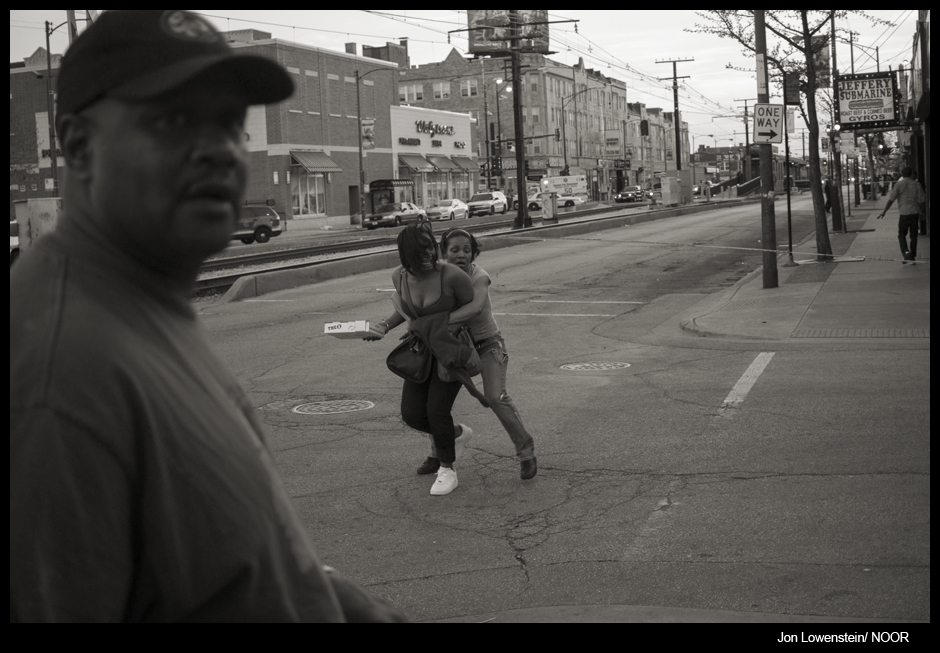 A young woman tries to restrain her friend in the middle of 71st St. shortly after a multiple shooting in the South Shore neighborhood.
A young woman tries to restrain her friend in the middle of 71st St. shortly after a multiple shooting in the South Shore neighborhood.
There’s a saying on the South Side that the first warm day of the year always brings the crazy out in people. This year was no different. Tuesday was one of the warmest days of the year, breaking 85 degrees. Within a 24-hour period twenty people were shot with three killed in the city. It feels strange to be able to write this so matter-of-factly, but when the warm weather arrives, we almost expect violence. It’s an inverted rite of passage that seems to happen every spring.
This past Tuesday night I was editing a short film about the impact of social violence across generations in the community and went out to get a bite to eat. The sun had just set as I exited the building. On my way out the entryway, one of my neighbors casually mentioned that I missed it.
“What did I miss?” I asked, not knowing.
“Yeah, someone just got shot, up on 71st by the Walgreen’s,” he replied.
“Well I can’t get to everyone.” We both chuckled.
“True, true.”
I was faced with a choice. Do I detour a few blocks and go to the crime scene or do I continue directly to the Jamaican restaurant which I was eager to try for the first time? My photographic desire won out and I drove to the corner of 71st and Clyde where I saw the flashing lights. One of the wounded was still being attended to, police were everywhere and residents and bystanders were checking out the scene. I parked in the lot, grabbed the little camera I take with me everywhere and started exploring the scene.
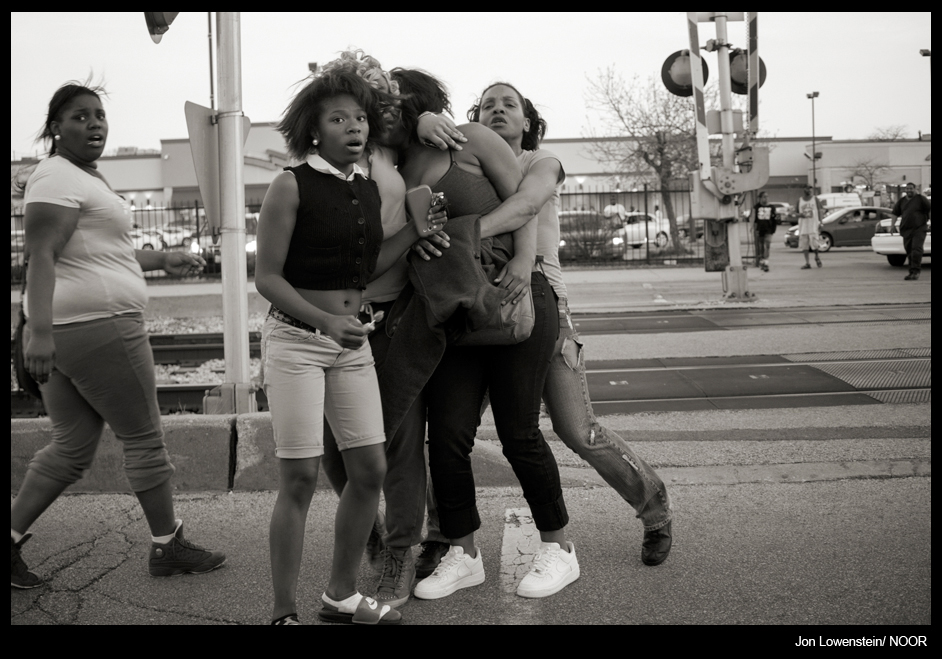 Girls who just heard seven to eight shots fired look to see if their friends are either injured or being detained by the police. The perpetrators fired the shots just minutes after two men were injured in a shooting at the corner of 71st and Jeffrey in Chicago’s South Shore neighborhood.
Girls who just heard seven to eight shots fired look to see if their friends are either injured or being detained by the police. The perpetrators fired the shots just minutes after two men were injured in a shooting at the corner of 71st and Jeffrey in Chicago’s South Shore neighborhood.
Often the aftermath of crime scenes are intensely mundane. Someone’s life has just been taken or irrevocably changed and there’s not much for the onlookers to do. Watch, chat, yell at the police or simply stare. It’s a strange social space that we witness with too much regularity in South Shore. Sometimes the crime scene aftermath is chaotic: family members arrive at the scene, people get upset and can turn on you. It’s important to keep your wits about you.
At this shooting, I photographed the wounded man on the stretcher being loaded into the waiting ambulance and then crossed the street. I took a few pics and crossed back. It was quiet. I took a few shots of a piece of yellow crime tape floating like a lasso above a policeman’s head.
Crack, crack, crack…
Seven to eight loud shots rang out in the evening air. I tried to see where they were coming from as people screamed and shouted. I ducked and saw people running, full-sprint. I was separated from the street by train tracks…there was nowhere to get cover so I crouched in the middle of the street.
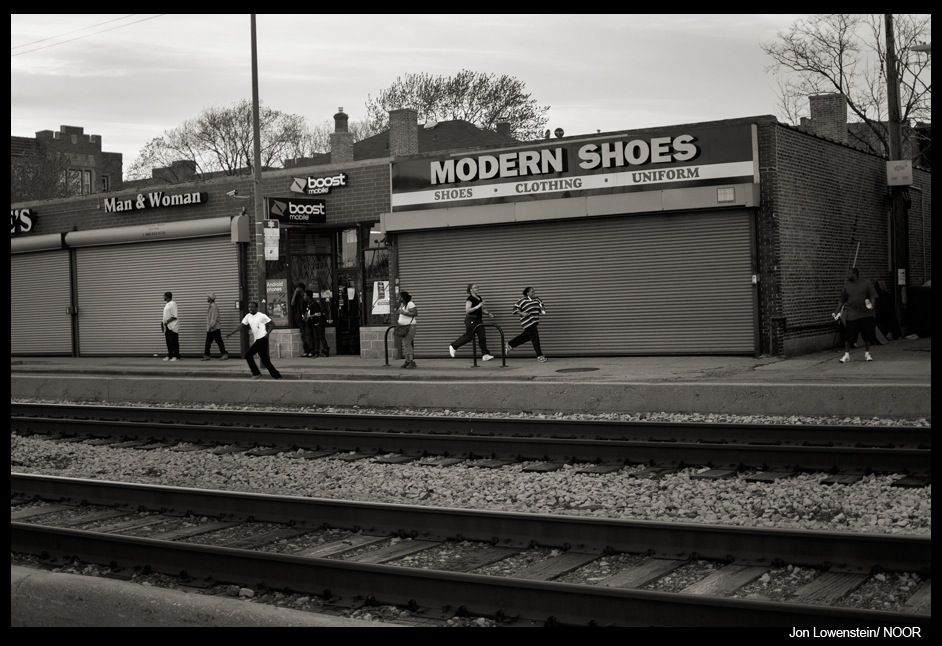 Bystanders run away from shots being fired near the corner of 71st and Clyde . In the past year South Shore has been home to more than 100 shootings, some with multiple victims. In December 2012, five people were shot at the same time; in August eight people were shot in a drive by gang shooting.
Bystanders run away from shots being fired near the corner of 71st and Clyde . In the past year South Shore has been home to more than 100 shootings, some with multiple victims. In December 2012, five people were shot at the same time; in August eight people were shot in a drive by gang shooting.
When the shooting stopped I began photographing. The scene was still chaotic: people running, young women hugging each other, the police standing over three men on the ground. A white sedan screamed away from the shooting scene and down 71st with a young man laughing out the window. The car nearly rear-ended a turning car, swerved around it and raced away. I wondered if they were the shooters, but had no idea.
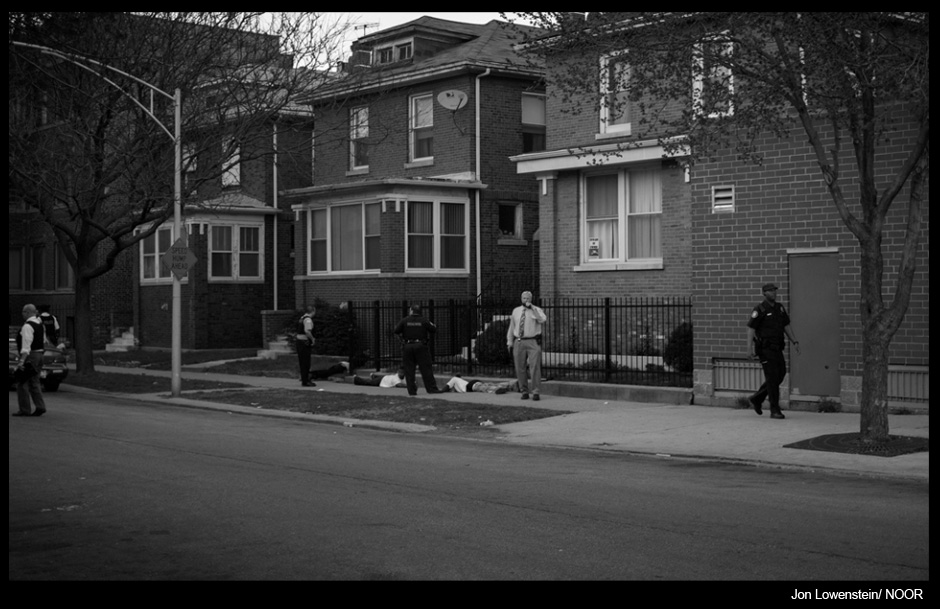 Police detain young men who they suspect of firing shots shortly after a multiple shooting in the South Shore neighborhood.
Police detain young men who they suspect of firing shots shortly after a multiple shooting in the South Shore neighborhood.
I went closer to where shooting had happened and the police yelled at me to get out or get arrested. I pushed it and tried to get closer to the three men face down on the ground. The police yelled at me again. I couldn’t tell if the men on the ground were wounded or were perps. I continued to photograph. Police raced around in their cars and detained more people looking for the shooters.
As it quieted down and I stopped and thought about what had just happened, I thanked my lucky stars, got in my car again and headed one mile south to 79th St. just west of Jeffrey to order my Jerk Chicken dinner.
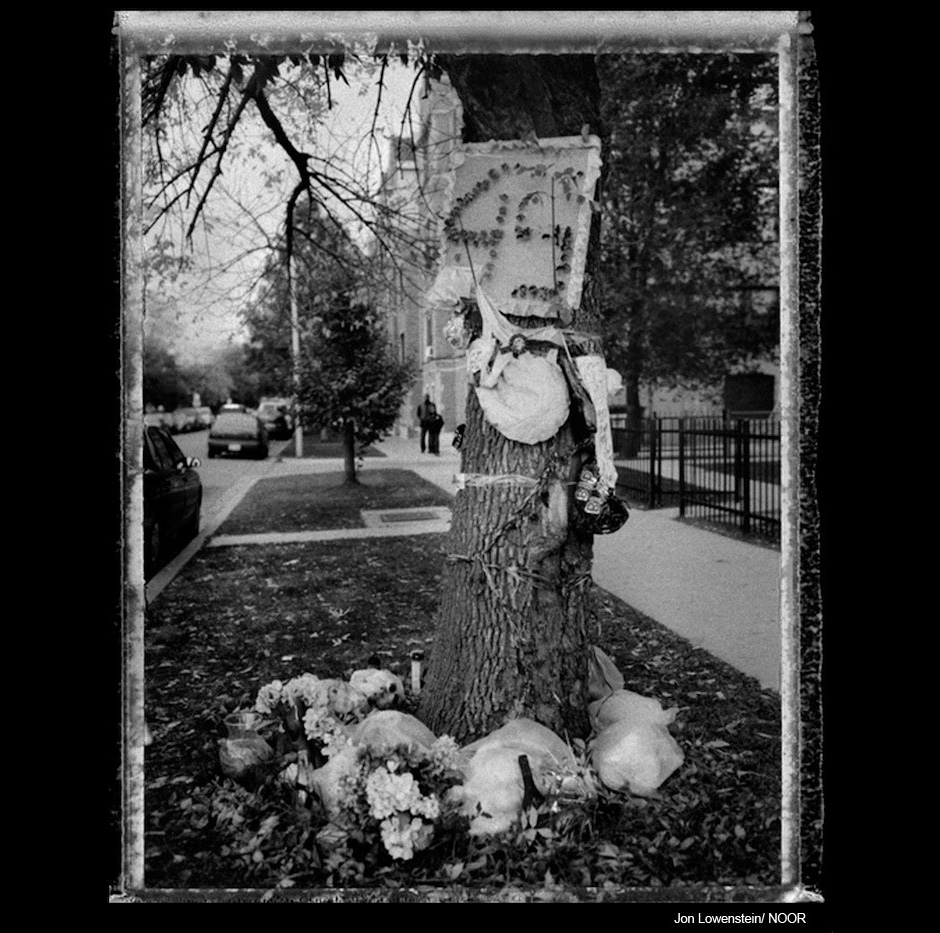
A memorial for Leonard Truss, a young man who was killed on 45th St. just east of Martin Luther King Jr. Blvd. in the Kenwood/Oakland neighborhood. Hundreds of Chicago public school children have been killed during the past decade.
Living in a community with a high level of social violence is a strange thing. It enters your emotional and physical space in unique and sometimes unexpected ways. Because I care about what’s happening in my community and in the larger South Side, I have chosen to photograph the impact of social and structural violence within the neighborhoods where I reside. I seek out places where violence has occurred. This puts me in harm’s way, but I believe I need to do it to show what’s going on in our city.
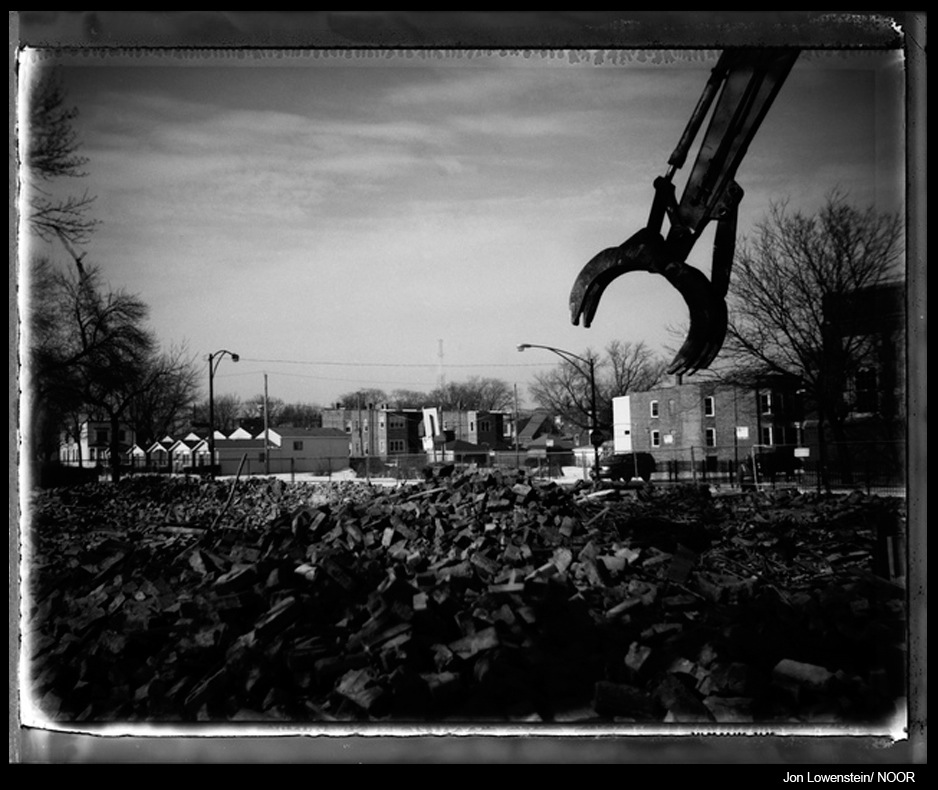 The South Side of Chicago’s once proud industrial communities fell onto hard times during the 1970s and 1980s, changing from thriving working class communities to neighborhoods rife with unemployment, poverty, drugs and gang violence. Despite this adversity, many residents hold and guard deep feelings of affection for their communities, even as they are threatened by the forces of gentrification.
The South Side of Chicago’s once proud industrial communities fell onto hard times during the 1970s and 1980s, changing from thriving working class communities to neighborhoods rife with unemployment, poverty, drugs and gang violence. Despite this adversity, many residents hold and guard deep feelings of affection for their communities, even as they are threatened by the forces of gentrification.
It’s also vital that we examine the factors that make violence flourish. There is now renewed interest and an intense profit motive in exploiting and gentrifying the poorest areas of the city. I’ve watched the Chicago Public Housing projects come down, development on the South Side’s lakefront, schools closed and re-opened and blocks upon blocks of the neighborhoods eroded by predatory lending that lead to large scale foreclosures. The South Side’s land is no longer seen as a pariah, to be shunned at all cost. There’s money to be made and deals to be struck!
The never ending focus on violence also obfuscates the true living conditions that exist in Chicago’s South Side. As I traverse the community I’m struck with how the space is being changed, guarded, abandoned – used, but unused at the same time. My goal is to document this space between the post-industrial meltdown and the place where Starbucks and the repackaged city arrives. My photographs and short films seek to make the unseen seen and force the viewer to contemplate what’s going on in our country right now.
I moved to the South Side eight years ago, but have been hanging out, photographing, teaching and interacting here for more than fifteen years. It has been a true love affair replete with its own ups and downs, heartbreaks and, ultimately, the realization that it’s a damn hard place to live.
I hope to use this space on BagNews Originals as a way to explore the feelings, thoughts and daily realities of living here in a community that is seen in such a fiercely negative light. My hope is that together we can understand the impact of our political and economic choices. The South Side is a journey between hope and despair in a place that was abandoned by white America more than forty years ago. Now that it is being reclaimed, repackaged and resold to a new generation, it can be ignored no more.
— Jon Lowenstein
PHOTOGRAPHS by JON LOWENSTEIN/NOOR
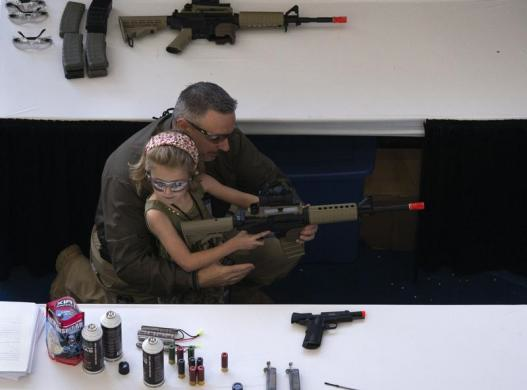

Reactions
Comments Powered by Disqus